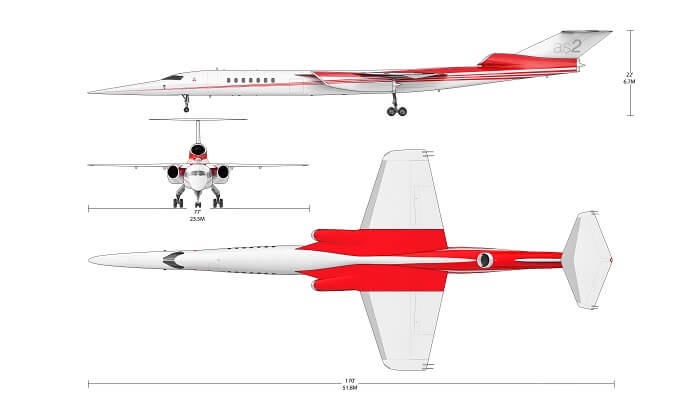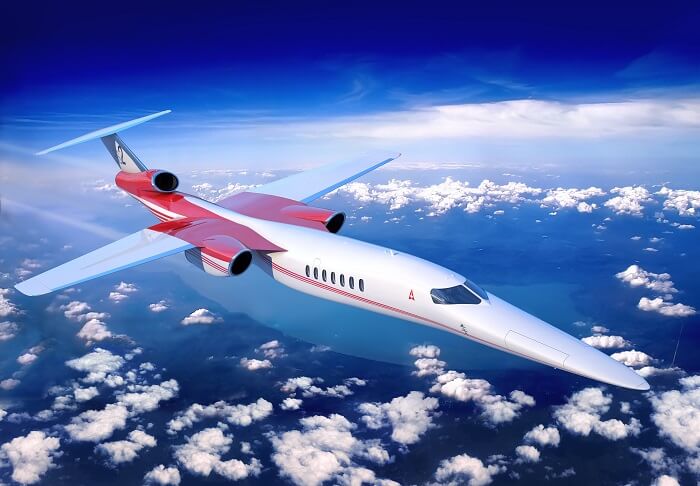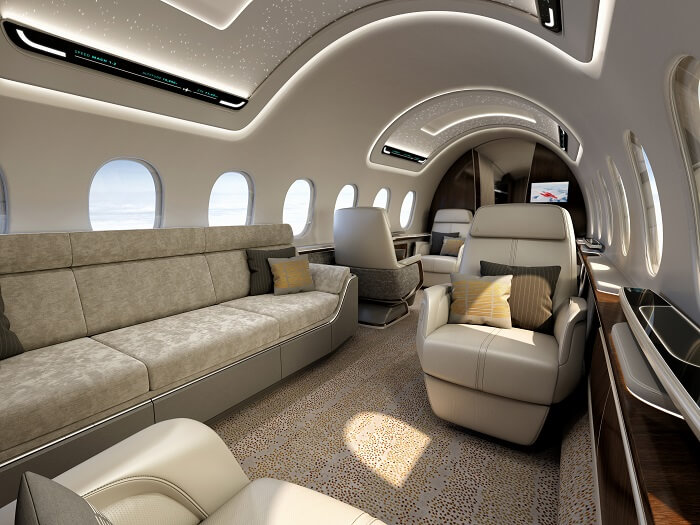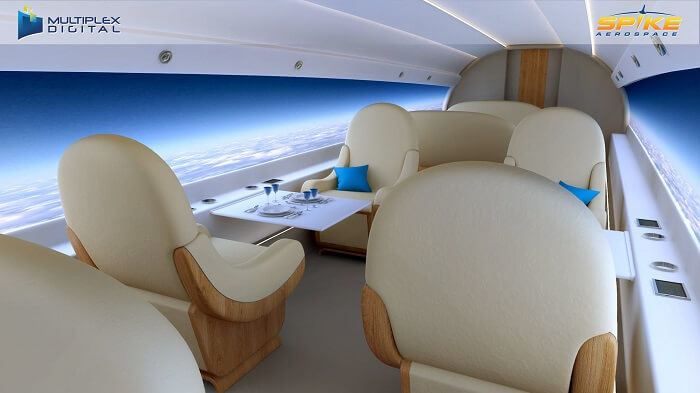Updated on February 5, 2019, to include additional images.
Three upstart companies – Boom Supersonic, Aerion and Spike Aerospace – seem to be edging closer towards the reintroduction of supersonic flight for civilians. Firm believers in the commercial success of transoceanic routes, all three companies have received orders for their aircraft and hope to start delivering them in the mid-2020s.
Boom recently concluded its second investment round collecting a total of $100 million to help assemble the first prototype of its Overture plane (cruising speed of Mach 2.2). Having already test flown its subscale prototype, Spike is reportedly in the process of selecting an engine for its S-512 (Mach 1.6) aircraft. Meanwhile, Aerion is already considering commercial variants of its AS2 (Mach 1.4) supersonic business jet. While Boom is focused on supersonic civilian airliners, Aerion and Spike are exclusively focused on the private business jet market.
Most of these companies advertise their planes as not only “the fastest” aircraft, but also promising “low-boom” flight. In fact, the future of these projects hinges mostly on whether the new supersonic aircraft will be able to meet current noise standards.
Although regulations are being loosened up in the U.S., civilian supersonic flight overland is restricted globally due to the “sonic boom” that such aircraft produce. Aside of aerodynamic innovations and new materials, developers are putting their bets on new engine designs, which they believe hold the potential to building a “quiet” supersonic plane.
The Overture
Boom Technology expects the first flight of its supersonic aircraft by the end of 2019. On January 4, 2019, the company announced it managed to collect $100 million of funds in its second research for investors. Founders and early backers of companies like Google, Airbnb, Stripe, and Dropbox are investing in Boom along with Investors, led by Emerson Collective, include Y Combinator Continuity, Caffeinated Capital, and SV Angel. In total, Boom managed to receive $141 million of funding.
The company’s main objective now is to complete the next phase of its project: get its supersonic demonstrator plane, the XB-1, in the air. The XB-1 (also known as Baby Boom) is a ⅓-scale manned Overture prototype which is currently under construction in Centennial, Colorado. It is powered by General Electric J85 engine. Boom will be announcing the final engine for the Overture aircraft later this year.
The XB-1 subscale prototype (Image: Boom Supersonic)
The final Overture aircraft should be half the size of the Concorde. It will only carry 55 passengers (against 100 for its famous ancestor). “Overture fares will be similar to today’s business class,” said Blake Scholl, founder and CEO of Boom Supersonic, adding that, “ultimately, our goal is to make high-speed flight affordable to all.”
The Overture (Image: Boom Supersonic)
Three engines will allow the Overture to fly further, but use less fuel and be less noisy, with a sonic boom “at least 30 times quieter” than the Concorde, claims the company. The first scheduled flight of the Mach-2.2 (2715 km/h) commercial airliner is expected to take place in mid-2020s. The startup says its supersonic aircraft will be flying oceanic routes. Pre-orders were placed by Virgin Group and Japan Airlines for a total of 30 Overture aircraft.
The Overture interior (Image: Boom Supersonic)
The Aerion AS2
Aerion Supersonic announced in October 2018 it had concluded the conceptual design phase for its 12-seat supersonic business jet, the AS2. The company says it is now aiming to conclude the preliminary design stage in June 2020.
The AS2 would have the capability of Mach 1.4 (over 1,000 mph), enabling it to fly directly from New York to Sao Paulo and London to Beijing (for comparison, the speed of subsonic business jets stands at Mach 0.9). Aerion is also planning to develop larger and faster variants of the AS2 that could serve as a larger cabin, longer-range business jet and potentially, a small commercial airliner.
The concept design of the AS2 (Image: Aerion Supersonic)
“We are starting with a business jet because the technology closes and the business case closes—we see a viable market for the AS2. It will be our springboard to larger and faster designs, both for business aviation and commercial airliners,” Aerion CEO Tom Vice has stated.
Aerion is collaborating with GE Aviation, Lockheed Martin and Honeywell to develop the AS2. GE Aviation announced it completed the initial design of the first supersonic engine for business jets in October 2018, naming the new engine class as he GE Affinity turbofan.
The AS2 (Image: Aerion Supersonic)
Like its rivals, Aerion proclaims it is expecting its AS2 business jet to take off for its first flight in 2023.
The AS2 interior (Image: Aerion Supersonic)
The Spike S-512
Spike Aerospace is developing a “quiet” supersonic airplane known as the Spike S-512 Quiet Supersonic Jet. The company is aiming for the S-512 to have a sonic signature less than 75 PLdb (perceived loudness level) at ground level, likened to the sound of a soft clap.
The S-512 would seat 12 to 18 passengers and be able to fly up to 6,200 nautical miles at cruising speed of Mach 1.6 (1,100 mph). That would allow for non-stop flights such as from New York to London in just three to four hours.
Spike has already flown its subsonic subscale SX-1.2 demonstrator plane. The jet completed seven test flights back in 2017. Having held talks with GE and Rolls-Royce, the manufacturer is currently in the process of selecting an engine for its plane. The $125 million S-512 jet is being developed with the help of Greenpoint Technologies and Siemens.
The Spike S-512 (Image: Spike Aerospace)
According to Reuters, Spike already has two orders for the aircraft and is conducting ongoing discussions with a commercial airline. The Boston-based company plans to manufacture four supersonic test aircraft and is aiming to start test flights in two years. The jet is expected to enter into service in mid-2020s.
The Spike S-512 interior (Image: Spike Aerospace)
Boeing & Lockheed Martin
In June last year, Boeing released the first concept of its hypersonic passenger plane, one of the several that company engineers are currently studying. Not many details, including the name of the aircraft, are yet known, except that the plane would have a variety of potential applications, including military. Were hypersonic aircraft to be produced, they would be capable of travelling at the speed of Mach 5 (4,000 mph).
If 2018 seems to have been a good year for supersonic passenger plane projects, that’s because it was. Prior to Boeing’s announcement, in April last year, Lockheed Martin revealed it had partnered up with NASA to build a low-boom flight demonstration aircraft that could minimize the sound of the sonic boom to that of a car door closing. Under the deal, Lockheed Martin Skunk Works will build an experimental aircraft, known as the X-plane, of its preliminary design developed with NASA’s Quiet Supersonic Technology (QueSST).









